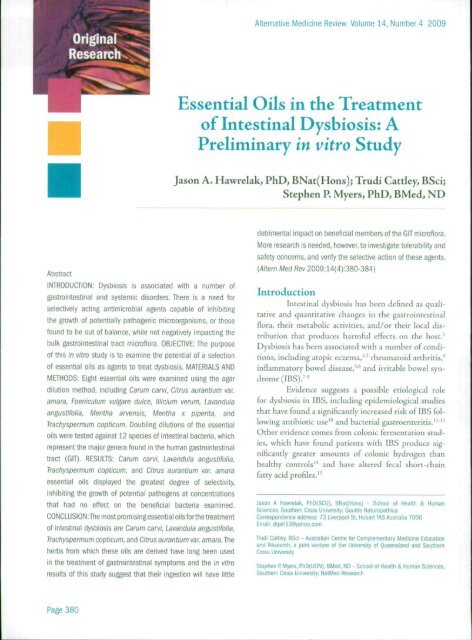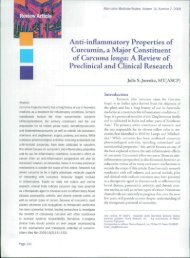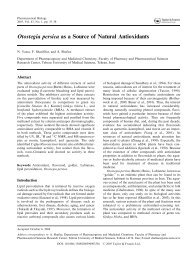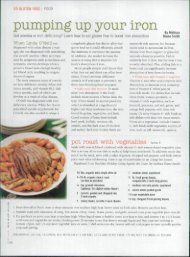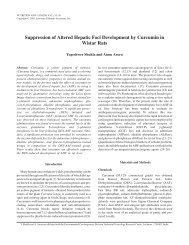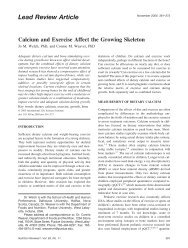Essential Oils in the Treatment of Intestinal Dysbiosis: A Preliminary ...
Essential Oils in the Treatment of Intestinal Dysbiosis: A Preliminary ...
Essential Oils in the Treatment of Intestinal Dysbiosis: A Preliminary ...
You also want an ePaper? Increase the reach of your titles
YUMPU automatically turns print PDFs into web optimized ePapers that Google loves.
Alternative Medic<strong>in</strong>e Review Volume 14, Number 4 2009<br />
<strong>Essential</strong> <strong>Oils</strong> <strong>in</strong> <strong>the</strong> <strong>Treatment</strong><br />
<strong>of</strong> Intest<strong>in</strong>al <strong>Dysbiosis</strong>: A<br />
Prelim<strong>in</strong>ary <strong>in</strong> vitro Study<br />
Jason A. Hawrelak, PhD, BNat(Hons); Trudi Cattley, BSci;<br />
Stephen R Myers, PhD, BMed, ND<br />
Abstract<br />
INTRODUCTION: <strong>Dysbiosis</strong> is associated with a number <strong>of</strong><br />
gastro<strong>in</strong>test<strong>in</strong>al and systemic disorders. There is a need for<br />
selectively act<strong>in</strong>g antimicrobial agents capable <strong>of</strong> <strong>in</strong>hibit<strong>in</strong>g<br />
<strong>the</strong> growth <strong>of</strong> potentially pathogenic microorganisms, or those<br />
found lo be out <strong>of</strong> balance, while not negatively impact<strong>in</strong>g <strong>the</strong><br />
bulk gastro<strong>in</strong>test<strong>in</strong>al tract micr<strong>of</strong>lora. OBJECTIVE; The purpose<br />
<strong>of</strong> this <strong>in</strong> vitro study is to exam<strong>in</strong>e <strong>the</strong> potential <strong>of</strong> a selection<br />
<strong>of</strong> essential oils as agents to treat dysbiosis. MATERIALS AND<br />
METHODS: Eight essential oils were exam<strong>in</strong>ed us<strong>in</strong>g <strong>the</strong> agar<br />
dilution method, <strong>in</strong>clud<strong>in</strong>g Carum cam, Citrus aurantium var.<br />
amara, Foeniculum vulgäre dulce, Illicium verum, Lavandula<br />
angustifotia, Mentha arvensis, Menffta x piperita, and<br />
Trachyspermum copticum. Doubl<strong>in</strong>g dilutions <strong>of</strong> <strong>the</strong> essential<br />
oils were tested aga<strong>in</strong>st 12 species <strong>of</strong> <strong>in</strong>test<strong>in</strong>al bacteria, which<br />
represent <strong>the</strong> major genera found <strong>in</strong> <strong>the</strong> human gastro<strong>in</strong>test<strong>in</strong>al<br />
tract (GIT). RESULTS: Carum carvi, Lavandula angustifolia,<br />
Trachyspermum copticum, and Dims aurantium var. amara<br />
essential oils displayed <strong>the</strong> greatest degree <strong>of</strong> selectivity,<br />
<strong>in</strong>hibit<strong>in</strong>g <strong>the</strong> growth <strong>of</strong> potential pathogens at concentrations<br />
that had no effect on <strong>the</strong> beneficial bacteria exam<strong>in</strong>ed.<br />
CONCLUSION:The most promis<strong>in</strong>g essential oilsfor<strong>the</strong> treatment<br />
<strong>of</strong> <strong>in</strong>test<strong>in</strong>al dysbiosis are Carum carvi, Lavandula angustifolia.<br />
Trachyspermum copiicum. and Citrus aurantium var. amara. The<br />
herbs from which <strong>the</strong>se oils are derived have long been used<br />
<strong>in</strong> <strong>the</strong> treatment <strong>of</strong> gastro<strong>in</strong>test<strong>in</strong>al symptoms and <strong>the</strong> <strong>in</strong> vitro<br />
results <strong>of</strong> this study suggest that <strong>the</strong>ir <strong>in</strong>gestion will have little<br />
detrimental impact on beneficial members <strong>of</strong> <strong>the</strong> GIT micr<strong>of</strong>lora.<br />
More research is needed, however, to <strong>in</strong>vestigate tolerability and<br />
safety concerns, and verify <strong>the</strong> selective action <strong>of</strong> <strong>the</strong>se agents,<br />
(^/tern Med Rev 2009:14(4):380-384)<br />
Introduction<br />
Intest<strong>in</strong>al dysbiosis has been def<strong>in</strong>ed as qualitative<br />
and quantitative changes <strong>in</strong> <strong>the</strong> gastro<strong>in</strong>test<strong>in</strong>al<br />
flora, <strong>the</strong>ir metabolic activities, and/or <strong>the</strong>ir local di.stribution<br />
that produces harmful efîects on <strong>the</strong> host.'<br />
<strong>Dysbiosis</strong> has been associated with a number <strong>of</strong> conditions,<br />
<strong>in</strong>clud<strong>in</strong>g atopic eczema,^' rheumatoid arthritis,**<br />
<strong>in</strong>flammatory bowel disease,^'' and irritable bowel syndrome<br />
(IBS)/"<br />
Evidence suggests a possible etiological role<br />
for dysbiosis <strong>in</strong> IBS, <strong>in</strong>clud<strong>in</strong>g epidemiological studies<br />
that have found a significantly <strong>in</strong>creased risk <strong>of</strong> IBS follow<strong>in</strong>g<br />
antibiotic use'" and bacterial gastroenteritis.""<br />
O<strong>the</strong>r evidence comes from colonie fermentation studies,<br />
which have found patients with IBS produce significantly<br />
greater amounts <strong>of</strong> colonie hydrogen than<br />
healthy controls'' and have altered fecal short-cha<strong>in</strong><br />
fatty acid pr<strong>of</strong>iles.'^<br />
Jason A Hawrelak, PhD(SCU), BNat(Hons) - School <strong>of</strong> Health & Human<br />
Sciences. Sou<strong>the</strong>rn Cross University; Goulds Naturopathica<br />
Correspondence address: 73 Liverpool St, Hobart TAS Australia 7000<br />
Email: drjahl3@yahoo.com<br />
Trudi Cattley. BSci - Australian Centre for Complementary Medic<strong>in</strong>e Education<br />
and Research, a jo<strong>in</strong>t venture <strong>of</strong> <strong>the</strong> University <strong>of</strong> Queensland and Sou<strong>the</strong>rn<br />
Cross University<br />
Stephen R Myers, PhD(UON), BMed. ND - School <strong>of</strong> Health & Human Sciences,<br />
Sou<strong>the</strong>rn Cross Univereity: NatMed-Research<br />
Page 380
Alternative Medic<strong>in</strong>e Review Volume 14, Number 4 2009<br />
Tliete is also direct evidence that <strong>the</strong> gastro<strong>in</strong>test<strong>in</strong>al<br />
tract (GIT) micr<strong>of</strong>lora <strong>of</strong> IBS patients differs from<br />
that <strong>of</strong> healthy <strong>in</strong>dividuals. An older study found IBS patients<br />
have significantly fewer coliform bacteria, lactobacilii,<br />
and bifidobacteria than controls.'' These f<strong>in</strong>d<strong>in</strong>gs are<br />
supported by more recent smdies that found lower fecal<br />
concentrations <strong>of</strong> bifidobacteria <strong>in</strong> IBS patients, as well as<br />
lower levels <strong>of</strong> lactobacilli <strong>in</strong> diarrhea-predom<strong>in</strong>ant IBS<br />
patients/<br />
Whe<strong>the</strong>r this dysbiosis plays a role <strong>in</strong> <strong>the</strong> symptomatology<br />
<strong>of</strong> IBS has not been conclusively proven.<br />
However, <strong>the</strong> efficacy <strong>of</strong> probiotic agents <strong>in</strong> treat<strong>in</strong>g this<br />
condition"'''^ <strong>in</strong> comb<strong>in</strong>ation with evidence outl<strong>in</strong>ed<br />
above suggests a possible etiological role.<br />
Thus, <strong>the</strong>re is a need for selectively act<strong>in</strong>g antimicrobial<br />
agents capable <strong>of</strong> <strong>in</strong>hibit<strong>in</strong>g <strong>the</strong> growth <strong>of</strong> potentially<br />
pathogenic microorganisms, or those found to<br />
be out <strong>of</strong> balance, while not negatively impact<strong>in</strong>g <strong>the</strong> bulk<br />
GIT micr<strong>of</strong>lora. In addition, s<strong>in</strong>ce such agents may be<br />
prescribed concurrent with probiotics, it is beneficial that<br />
<strong>the</strong> antimicrobial agent not <strong>in</strong>terfere with <strong>the</strong> growth <strong>of</strong><br />
<strong>the</strong> supplemented probiotic organisms (e.g., lactobacilli<br />
and bifidobacteria).<br />
Objective<br />
The objective <strong>of</strong> this study is to exam<strong>in</strong>e <strong>the</strong> potential<br />
<strong>of</strong> a selection <strong>of</strong> essential oils as agents to treat<br />
<strong>in</strong>test<strong>in</strong>al dysbiosis. The essential oils <strong>in</strong>vestigated were<br />
chosen from carm<strong>in</strong>ative herbs traditionally used <strong>in</strong> <strong>the</strong><br />
treatment <strong>of</strong> gastro<strong>in</strong>test<strong>in</strong>al disorders, <strong>in</strong>clud<strong>in</strong>g Carum<br />
carvi (caraway). Citrus aurayitium var. amara (bitter orange),<br />
Foeniculum vulgäre dulec (sweet fennel), Illicium<br />
verum (star anise), Lavandula augustifolia (lavender),<br />
Mentha arvensis (Japanese pepperm<strong>in</strong>t), Mentha xpiperita<br />
(pepperm<strong>in</strong>t), and Trachyspermum copticum (ajowan).<br />
Materials and Methods<br />
<strong>Essential</strong> <strong>Oils</strong><br />
Pure essential oils were purchased from two<br />
sources: New Directions (Sydney, NSW, Australia) and<br />
Sydney <strong>Essential</strong> Oil Company (Sydney, NSW, Australia).<br />
Tlie essential oils purchased from New Directions <strong>in</strong>cluded<br />
Carum carvi, Foeniculum vulgäre dulce, JlHcium verum,<br />
Mentha x piperita, and Trachyspermum copticum. Mentha<br />
arvensis, Lavandula angustijoUa, and Citrus aurantium var.<br />
amara were sourced from Sydney <strong>Essential</strong> Oil Company.<br />
Organisms and Growth Conditions<br />
Microorganisms were obta<strong>in</strong>ed from <strong>the</strong> Australian<br />
Collection <strong>of</strong> Microorganisms, University <strong>of</strong><br />
Queensland, with <strong>the</strong> exception <strong>of</strong> Bißdohacterntm hißdum<br />
and Bißdobacterium lotigum, which were obta<strong>in</strong>ed<br />
from <strong>the</strong> CSIRO Starter Culture Collection. Organisms<br />
were as follows: Bacteroides jragilis ACM 4768,<br />
Candida aWicans ACM 4574, Clostridium Mfficile ACM<br />
5047, Clostridium perfr<strong>in</strong>gcns ACM 5116, Enterococcus<br />
faecalis ACM 4769, Escherichia coii ACM 1083, Eubacterium<br />
limosum ACM 383, Lactobacillus acidophilus<br />
ACM 547, Lactobacillus plautarum ACM 96, Bißdobacterium<br />
bißdum CSCC 1903, Bißäobacterium longum<br />
CSCC 5188, and Peptostreptococcus anaerolmts ACM<br />
5059. These organisms represent <strong>the</strong> major genera ot<br />
microorganisms found <strong>in</strong> <strong>the</strong> human GIT.^"<br />
Organisms were ma<strong>in</strong>ta<strong>in</strong>ed on Re<strong>in</strong>forced<br />
Clostridial Agar (Oxoid), Wilkens-Chalgren Anaerobe<br />
Agar (Oxoid), Mueller H<strong>in</strong>ton Agar (Oxoid), or De-<br />
Man Rugosa Sharpe Agar (Oxoid). Inoculum was prepared<br />
by suspend<strong>in</strong>g colonies from 24-72 hour cultures<br />
<strong>in</strong> sterile sal<strong>in</strong>e. Us<strong>in</strong>g a CrystalSpec Nephelometer'"<br />
(Becton Dick<strong>in</strong>son & Company, Maryland, USA) suspensions<br />
were standardized to a 0.5 McFarland standard,<br />
giv<strong>in</strong>g ~10" colony form<strong>in</strong>g units (CFU) per mL<br />
for <strong>the</strong> bacteria and 10' CFU per mL for Candida albicans.<br />
Aerobic bacteria were diluted 1:10 <strong>in</strong> sal<strong>in</strong>e prior<br />
to <strong>in</strong>oculation.<br />
M<strong>in</strong>imum Inhibitory Concentration<br />
(MIC) Determ<strong>in</strong>ation<br />
MICs were determ<strong>in</strong>ed by agar dilun'on us<strong>in</strong>g<br />
Mueller H<strong>in</strong>ton Agar for anaerobic organisms,<br />
Wilkens-Chalgren Anaerobe Agar for all anaerobes<br />
except <strong>the</strong> two Lactobacillus species, which were grown<br />
on DeMan Rogosa Sharpe Agar. A series <strong>of</strong> tw<strong>of</strong>old<br />
dilutions <strong>of</strong> each essential oil (from 2.0-0.004 percent<br />
volume per volume [v/v]) was prepared and placed<br />
<strong>in</strong> sterile Petri dishes. Each dilution was placed <strong>in</strong>to<br />
three Petri dishes and one ot three agars was added to<br />
each plate and mixed thoroughly. Tween-20 (Sigma)<br />
was <strong>in</strong>corporated <strong>in</strong>to <strong>the</strong> agar at a concentration <strong>of</strong><br />
0.5 percent (v/v) to enhance solubility. Cl<strong>in</strong>damyc<strong>in</strong>,<br />
neomyc<strong>in</strong>, ampicill<strong>in</strong>, and ketoconazole (<strong>in</strong> doubl<strong>in</strong>g<br />
dilutions from 64 to 0.05 fig/mL) were used as positive<br />
controls, while dimethylsulfoxide (DMSO), Tween-20,<br />
Page 381
Alternative Medic<strong>in</strong>e Review Volume 14, Number 4 2009<br />
n<br />
u<br />
0<br />
ero<br />
• M<br />
-fi<br />
stri<br />
w<br />
"^C3 n<br />
T.<br />
O<br />
(A<br />
aqui<br />
C<br />
0<br />
g<br />
o<br />
c<br />
0<br />
•ß<br />
e<br />
sse<br />
elected<br />
0<br />
u<br />
sniqojaeup<br />
• '<br />
tu/uejue/fl s////aeQopP7<br />
ç n J J Í fff/l n 11D ç fH J J T D/l/ll 1D ~l<br />
3 "f'(J LJUUJ ^t* 3 ' irf I^JcTlJi/J iJ t: f<br />
ujnsoiUi¡ ujduoidGQnj<br />
1 im Dfi 1 ^í f ^ u 1 c T<br />
sudSuiJUdrl lí/n/Df/i^oín<br />
suBDfqie eptpue^<br />
SfjipBJi SdptOJQlOBQ<br />
E<br />
ca<br />
Common<br />
¡cal Name<br />
ota<br />
ca<br />
CN<br />
4.5<br />
m<br />
<strong>in</strong><br />
«^<br />
vn<br />
j<br />
<strong>in</strong><br />
f^<br />
0.2<br />
<strong>in</strong><br />
CNt<br />
d<br />
<strong>in</strong><br />
m<br />
Ö<br />
CN<br />
CN<br />
CN<br />
tn<br />
<strong>in</strong><br />
d<br />
Caraway<br />
s<br />
(O<br />
o<br />
E<br />
ys¡jcrniiim copticum,<br />
which <strong>in</strong>hibited <strong>the</strong> growth <strong>of</strong> all microorganisms<br />
at a concentration ot
Alternative Medic<strong>in</strong>e Review Voiume 14, Number4 2009<br />
Discussion<br />
Tlie antimicrobial properties <strong>of</strong> eight essential<br />
oils were evaluated aga<strong>in</strong>st common members <strong>of</strong><strong>the</strong> human<br />
gastro<strong>in</strong>test<strong>in</strong>al tract micr<strong>of</strong>lora. Tlie essential oils<br />
were chosen based on <strong>the</strong> traditional uses <strong>of</strong> <strong>the</strong> herbs<br />
from which <strong>the</strong> essential oils are derived. For example,<br />
Mentha x piperita,^ Carum carvip Foeniculum vulgäre<br />
dulce/'' Mentha arvensis,"'' Illicium veru<strong>in</strong>,^'' and Lavandula<br />
angustijolia~ have long been utilised as carm<strong>in</strong>atives<br />
<strong>in</strong> Western herbal medic<strong>in</strong>e. Citrus aurantium var.<br />
amara has a long history <strong>of</strong> use <strong>in</strong> traditional Ch<strong>in</strong>ese<br />
medic<strong>in</strong>e for gastro<strong>in</strong>test<strong>in</strong>al antispasmodic and carm<strong>in</strong>ative<br />
activities,'" and I'rachyspcrmum copticum has<br />
been used <strong>in</strong> Ayutvedic medic<strong>in</strong>e to relieve colic, flatulence,<br />
diarrhea, and dyspepsia.'"^<br />
Tlie most selectively act<strong>in</strong>g oils were Carum<br />
carvi, Lavandula angustijolia, and Trachyspermum copticum,<br />
which at one concentration <strong>in</strong>hibited <strong>the</strong> growth<br />
<strong>of</strong> a number <strong>of</strong> potentially pathogenic microorganisms<br />
{Candida alhicans, Clostridium spp., Bactcroides fragiUs),<br />
while hav<strong>in</strong>g no impact on <strong>the</strong> tour species <strong>of</strong> beneficial<br />
microbes exam<strong>in</strong>ed. Citrus aurantium var. amara essential<br />
oil was also selective <strong>in</strong> its activity. At concentrations<br />
that <strong>in</strong>hibited <strong>the</strong> growth o(Bacteroidcsjragilis and Clostridium<br />
perfr<strong>in</strong>gens, no o<strong>the</strong>r species <strong>of</strong> bacteria or fungi<br />
was affected. Hence, <strong>the</strong>se oils appear to have <strong>the</strong> most<br />
potential <strong>in</strong> <strong>the</strong> treatment <strong>of</strong> dysbiosis, where <strong>the</strong>ir use<br />
could help balance <strong>the</strong> GIT micr<strong>of</strong>lora.<br />
IBS patients have been found to have lower<br />
fecal counts <strong>of</strong> lactobacilii, bifidobacteria, and coliform<br />
bacteria/'^ The results <strong>of</strong> this study suggest that Carum<br />
carvi, Lavandula angustijolia, Trachyspermum copticum,<br />
and Citrus aurantium var. amara essential oils could be<br />
used <strong>in</strong> <strong>the</strong> treatment <strong>of</strong> IBS without negative ramifications<br />
on already disordered GIT micr<strong>of</strong>lora.<br />
O<strong>the</strong>r extracts were equally effective <strong>in</strong> kill<strong>in</strong>g<br />
both beneficial and potentially pathogenic members ot<br />
<strong>the</strong> GIT flora, <strong>in</strong>clud<strong>in</strong>g Mentha x piperita, Focnicidum<br />
vulgäre dulce, Mentha arvensis, and ¡llicium verum essential<br />
oils. Foeniculum vulgäre dulce and Illicium verum essential<br />
oils were, however, less active toward lactobacilii<br />
than bifidobacteria or <strong>the</strong> potentially pathogenic organisms.<br />
None<strong>the</strong>less, <strong>in</strong> concentrations that <strong>in</strong>hibited<br />
<strong>the</strong> growth ot potentially pathogenic microbes, some<br />
beneficial bacteria were also <strong>in</strong>hibited.<br />
Of <strong>the</strong>se agents, only Mentha x piperita is commonly<br />
prescribed, due to its demonstrated efficacy <strong>in</strong><br />
IBS.^"'" The study results suggest that <strong>the</strong> <strong>in</strong>gestion<br />
<strong>of</strong> M. X piperita essential oil may <strong>in</strong>hibit <strong>the</strong> growth oí<br />
some common members <strong>of</strong><strong>the</strong> GIT micr<strong>of</strong>lora. Until<br />
more research is conducted ascerta<strong>in</strong><strong>in</strong>g <strong>the</strong> <strong>in</strong> vivo effects<br />
<strong>of</strong> M. X piperita essential oil on GIT micr<strong>of</strong>lora,<br />
it is prudent to prescribe a probiotic agent (conta<strong>in</strong><strong>in</strong>g<br />
both bifidobacteria and lactobacilii) concurrently witli<br />
M. X piperita essential oil.<br />
Generalisation <strong>of</strong> <strong>the</strong>se results to <strong>in</strong> vivo situations<br />
is limited, however, by <strong>the</strong> nature <strong>of</strong> <strong>the</strong> study<br />
design. It is unknown what impact <strong>the</strong> processes <strong>of</strong><br />
digestion and absorption will have on an essential oil's<br />
antimicrobial activity. Thus, <strong>the</strong> results <strong>of</strong> this <strong>in</strong> vitro<br />
experiment need to be <strong>in</strong>terpreted cautiously and seen<br />
as solely prelim<strong>in</strong>ary. In vivo studies are needed to verify<br />
<strong>the</strong> selectivity <strong>of</strong> action displayed by <strong>the</strong>se essential oils,<br />
as well as to address tolerability and safety concerns.<br />
Future <strong>in</strong> vitro studies should take <strong>in</strong>to account<br />
o<strong>the</strong>r common members <strong>of</strong> <strong>the</strong> GIT flora, such as Rum<strong>in</strong>ococcus<br />
spp.. Streptococcus spp., Peptococcus spp.,<br />
Act<strong>in</strong>omyces spp., and Fusobacterium spp.,"" as well as<br />
gas-produc<strong>in</strong>g microbes like methanogens and sulfatereduc<strong>in</strong>g<br />
bacteria.^^ The effects <strong>of</strong> carm<strong>in</strong>atives on <strong>the</strong>se<br />
latter two groups <strong>of</strong> bacteria would be particularly <strong>in</strong>terest<strong>in</strong>g.<br />
However, <strong>the</strong> results would still be prelim<strong>in</strong>ary<br />
and would not provide def<strong>in</strong>itive evidence ot <strong>in</strong><br />
vivo effectiveness. Def<strong>in</strong>itive answers await randomized,<br />
double-bl<strong>in</strong>d, placebo-controlled human trials utiliz<strong>in</strong>g<br />
<strong>the</strong> "gold standard <strong>of</strong> niicr<strong>of</strong>iora assessment techniques<br />
- 16S ribosomal RNA sequenc<strong>in</strong>g - to accurately del<strong>in</strong>eate<br />
changes <strong>in</strong> <strong>the</strong> GIT micr<strong>of</strong>iora after <strong>in</strong>gestion <strong>of</strong><br />
<strong>the</strong>se essential oils.''<br />
Conclusion<br />
The most promis<strong>in</strong>g essential oils for <strong>the</strong> treatment<br />
<strong>of</strong> <strong>in</strong>test<strong>in</strong>al dysbiosis appear to be Carum carvi,<br />
Lavatidula angustijolia, Trachyspermum copticum, and<br />
Citrus aurantium var. amara. The herbs from which <strong>the</strong>se<br />
oils are derived have long been used <strong>in</strong> <strong>the</strong> treatment<br />
<strong>of</strong> gastro<strong>in</strong>test<strong>in</strong>al symptoms and <strong>the</strong>se <strong>in</strong> vitro results<br />
suggest that <strong>the</strong>ir <strong>in</strong>gestion will have little detrimental<br />
impact on beneficial GIT micr<strong>of</strong>lora. More research is<br />
needed to <strong>in</strong>vestigate tolerability, safety concerns, and<br />
verification <strong>of</strong> selectivity.<br />
Page 383
Alternative Medic<strong>in</strong>e Review Volume 14, Number 4 2009<br />
References<br />
1. HawrcIakJA, Myers SP. The causes <strong>of</strong> <strong>in</strong>test<strong>in</strong>al<br />
dysbiosis: a review, Ahem Med Rev 2004;9:180-197.<br />
2. Bjorlcstcn B, Sepp E, Julge K. er .il. Allerg)'<br />
development and <strong>the</strong> <strong>in</strong>test<strong>in</strong>al micr<strong>of</strong>lora dur<strong>in</strong>g <strong>the</strong><br />
first year <strong>of</strong> life.J Allergy CUn Immunol 2Ü01;108;516-<br />
520.<br />
3. Kaliionialci M, Kirjava<strong>in</strong>en R Eerola E, et al. Dist<strong>in</strong>ct<br />
patterns <strong>of</strong> neonatal gut micr<strong>of</strong>lora <strong>in</strong> <strong>in</strong>fants <strong>in</strong> whom<br />
atopy was and was not develop<strong>in</strong>g.J Allergy Cl<strong>in</strong><br />
ïmmunol200hl07:U9'134.<br />
4. Pelconen R, Nenoncn M, Helve T, et al. Faecal<br />
microbial Hora and disease activity <strong>in</strong> rheumatoid<br />
arthritis dur<strong>in</strong>g a vegan diet, BrJ Rheumatol<br />
1997:36:64-68.<br />
5. Onderdonk AB. Role <strong>of</strong> rhe <strong>in</strong>test<strong>in</strong>al micr<strong>of</strong>lota <strong>in</strong><br />
ulcerarive colitis. In: Hentges DJ, ed. Human Intest<strong>in</strong>al<br />
MiíTii/íora <strong>in</strong> Health and Disease. New York, NY:<br />
Academic Press; 1983:481-493.<br />
6. L<strong>in</strong>skens RK, Huijsdens XW, Savclkoul PH, et al.<br />
The bacterial flora <strong>in</strong> <strong>in</strong>flammatory bowel disease:<br />
current <strong>in</strong>sights <strong>in</strong> pathogenesis and che <strong>in</strong>fluence <strong>of</strong><br />
anribiocics and probiotics. ScandJ Gastroenterol Suppl<br />
2001;234:29-40.<br />
7. Balsari A, Ceccarelli A, Dub<strong>in</strong>i F, et al. The fecal<br />
microbial population <strong>in</strong> <strong>the</strong> irritable bowel syndrome.<br />
Microbiologica 1982;5:185-194.<br />
8. Si JM. Yu VC, Fan YJ, Chen SJ. Intest<strong>in</strong>al<br />
niicroecology and qu;ility <strong>of</strong> life <strong>in</strong> irritable<br />
bowel syndrome patients. World J Gastroenterol<br />
2004:10:1802-1805.<br />
9. Mal<strong>in</strong>en E. R<strong>in</strong>ttiia T, Kajander K, et al. Analysis<br />
<strong>of</strong><strong>the</strong> fecal niicrobioca ot irritable bowel syndrome<br />
patients and healthy controls with teal-time PCR. Am<br />
j Gastroenterol 2005:100:373-382.<br />
10. Mendall MA, Kumar D. Antibiotic use, childhood<br />
affluence and irritable bowel syndrome (IBS). Eurj<br />
Gastroenterol Hepatol 1998:10:59-62.<br />
11. Gwee KA, Leong YL, Graham C, et al. The role <strong>of</strong><br />
psychological and biological factors <strong>in</strong> postíníective<br />
gut dysfunction. Gut 1999;44:400-406.<br />
12. Rodriguez LA, Ruigomez A. Increased risk <strong>of</strong> irritable<br />
bowel syndrome after bacterial gastroenteritis: cohort<br />
.study. EMJ 1999;318:565-566,<br />
13. Alun Jones V, Wilson AJ, Hunter JO, et al. Tlie<br />
aetiological role oí antibiotic prophylaxis with<br />
hysterectomy <strong>in</strong> irritable bowel syndrome, / Ohstct<br />
Gynaecol 1984;5:S22-S23.<br />
14. K<strong>in</strong>gTS, Elia M, HunterJO. Abnormal colonie<br />
fermencacion <strong>in</strong> irritable bowel syndrome. Lancet<br />
1998;352:1187-1189.<br />
15. Treem WR, Absan N, Kastotf G, HyamsJS. Fecal<br />
short-cha<strong>in</strong> tatty acids <strong>in</strong> patients with diarrheapredom<strong>in</strong>ant<br />
irritable bowel syndrome: <strong>in</strong> vitro snidies<br />
<strong>of</strong> carbohydrate fermentation. J Pediatr Gastroenterol<br />
Nutr 1996:23:280-286.<br />
16. Halpern GM, Pr<strong>in</strong>diville T, Blankenburg M, ct al.<br />
<strong>Treatment</strong> <strong>of</strong> irritable bowel syndrome with Lacteol<br />
Fort: a randomized, double-bl<strong>in</strong>d, cross-over trial. jAm<br />
j Gastroenterol 1996;91:1579-1585.<br />
17. Nobaek S, Johansson ML, Mol<strong>in</strong> G, et al. Altetation<br />
<strong>of</strong> <strong>in</strong>test<strong>in</strong>al niicr<strong>of</strong>lora is associated with reduction <strong>in</strong><br />
abdom<strong>in</strong>al bloat<strong>in</strong>g and pa<strong>in</strong> <strong>in</strong> patients with irritable<br />
bowel syndrome. AmJ Castroenterol 2000:95:1231-<br />
1238.<br />
18. Niedziel<strong>in</strong> K. Kordecki H, Birkenfeld B. A controlled,<br />
double-bl<strong>in</strong>d, randomized study on tbe efficacy<br />
<strong>of</strong> Lactobacillus plamarum 299V <strong>in</strong> patients with<br />
irritable bowel syndrome. Eur} Gastroenterol Hepatol<br />
2001:13:1143-1147,<br />
19. Saggioro A. Probiocics <strong>in</strong> <strong>the</strong> treatment <strong>of</strong><br />
irritable bowel syndrome. / Cl<strong>in</strong> Gastroenterol<br />
2004;38:S104-S106.<br />
20. Conway PL. Microbial ecology <strong>of</strong> <strong>the</strong> human large<br />
<strong>in</strong>test<strong>in</strong>e. In: Gibson GR, Macbrlane GT, eds. Human<br />
Colonie Bacteria: Role <strong>in</strong> Nutrition, Physiology, and<br />
P
Copyright <strong>of</strong> Alternative Medic<strong>in</strong>e Review is <strong>the</strong> property <strong>of</strong> Thorne Research Inc and its content may not be<br />
copied or emailed to multiple sites or posted to a listserv without <strong>the</strong> copyright holder's express written<br />
permission. However, users may pr<strong>in</strong>t, download, or email articles for <strong>in</strong>dividual use.


